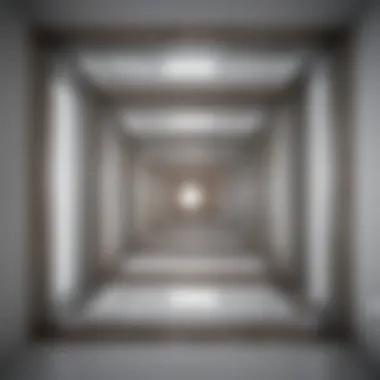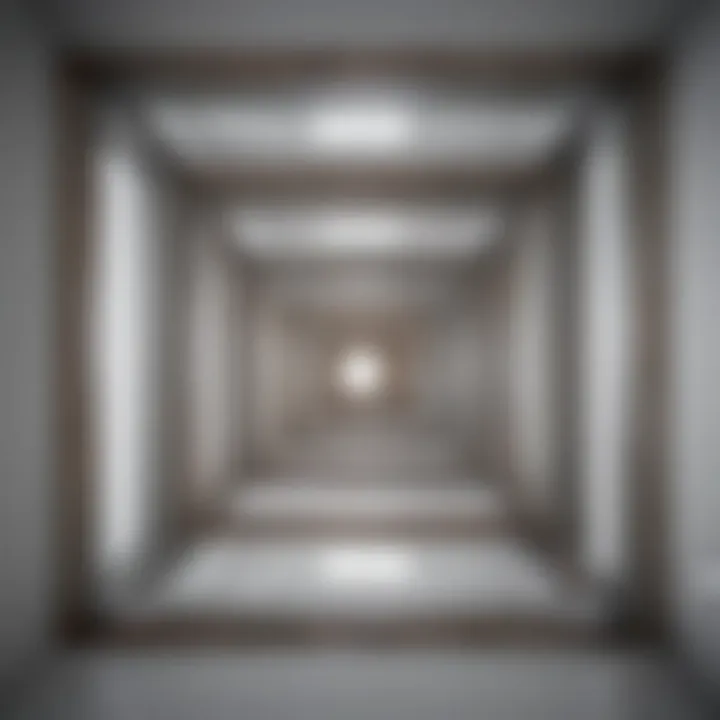Mastering Square Area Calculation: A Comprehensive Guide


Intro
Understanding the area of a square is a fundamental concept in geometry. The simplicity of the square, defined by equal sides and right angles, makes it an ideal starting point for those engaging in mathematical exploration. The primary formula to calculate the area is straightforward: multiply the length of one side by itself. However, beneath this surface lies a depth of significance that informs more advanced mathematical concepts.
Many students initially grasp this concept with ease, yet misconceptions frequently arise. Some may confuse area with perimeter, leading to errors in application. This underscores the importance of mastering this basic principle as a building block for further mathematical learning.
Understanding the Square
Understanding the concept of a square is foundational to geometric calculations, especially when it comes to determining area. A square is not just a simple shape; it exemplifies symmetry, regularity, and precision in mathematics. Every individual, from students to professionals, can benefit from comprehending its significance.
The area of a square is a fundamental measurement that finds application in various fields. Knowing how to calculate this area can aid in tasks ranging from interior design decisions to architectural planning. When one thoroughly understands a square's unique properties, it also becomes easier to transfer this knowledge to other geometrical shapes.
Definition of a Square
A square can be defined as a polygon with four equal sides and four right angles. Specifically, it is a regular quadrilateral. The defining characteristics of a square include:
- All sides are of equal length.
- The angles between adjacent sides are all 90 degrees.
- Opposite sides are parallel, adhering to the properties of parallelograms.
In mathematical terms, if one side of a square is denoted as "s", then all sides are represented as "s". This simplicity in definition makes squares an ideal shape for mathematical teaching and applicability.
Properties of a Square
The properties of a square extend beyond its shape and dimensions; they present intriguing aspects that are critical to understanding geometry as a whole. Some key properties include:
- Symmetry: A square exhibits four lines of symmetry, which make it visually appealing.
- Diagonals: The diagonals of a square are equal in length and bisect each other at right angles. This divides the square into four congruent right triangles.
- Area Calculation: The area (A) is calculated using the formula A = s². This formula is straightforward and applicable whenever the length of one side is known.
These properties contribute to the square's unique status in geometry and establish its relevance in various practical applications. Furthermore, its simple relationship between side length and area fosters mathematical reasoning and problem-solving skills.
Area Calculation Fundamentals
Understanding the fundamentals of area calculation is critical for grasping the broader concepts in geometry. Area is not just a measure of space; it has practical implications across various fields. From engineering to interior design, knowing how to calculate area affects the way spaces are utilized. Understanding how to calculate the area of simple shapes, particularly a square, sets a strong foundation for further studies in geometry and related disciplines.
The Concept of Area
The area of a geometric shape quantifies the amount of two-dimensional space it occupies. By determining area, one can make informed decisions about land use, materials needed for construction, and spatial organization. In a square, every side is equal. This characteristic allows for a simplified approach to calculating area, making it a fundamental concept for anyone studying mathematics. When working with area, it is crucial to have a clear definition and method of calculation.
Formula for Calculating Area of a Square
A = s²
In this formula, A represents the area, while s stands for the length of one side of the square. This formula is essential because it concisely reflects the relationship between the length of a side and the space the square occupies. The simplicity of this formula is a critical advantage, as it allows for quick calculations without the need for complex computations.
A = s²
The primary characteristic of A = s² is its directness. The formula elegantly encapsulates a fundamental property of squares. Since all sides are equal, squaring the length of one side provides the total area. This method saves time and reduces the chances of error during calculations. Also, its popularity in both learning and practical applications makes it a universally recognized formula.


Variable Definitions
Understanding Variable Definitions in the context of this formula is essential for accurate area calculation. In our case, the variable s must be clearly defined as the length of a side. This clarity prevents confusion, especially for beginners learning the concepts of area and geometry. Furthermore, it reinforces the notion that the side measurement must always be in the same unit, to ensure consistency in calculations.
Accurate variable definitions prevent errors and facilitate better comprehension of mathematical concepts. In the larger scope of calculations involving various geometric shapes, clearly defined variables pave the way for successful mathematical exploration and application.
Understanding the fundamentals of area calculation is key to mastering geometric concepts.
Step-by-Step Calculation Process
Identifying the Length of a Side
The first step involves identifying the length of one side of the square. This measurement is crucial because the area is directly dependent on this value. In practical scenarios, this length could come from a variety of contexts—measuring a room, constructing a garden, or creating a design layout. The importance of precision in measurement cannot be overstated; even a slight error can lead to significant discrepancies in the final area calculation.
Once the length is determined, it’s vital to ensure that it represents a single side of the square, as this will be used repeatedly in the next calculations. When dealing with real objects or designs, it is helpful to use a tape measure or a ruler for accuracy. This elementary step lays the groundwork for a successful area calculation, emphasizing the importance of getting it right from the start.
Applying the Formula
Simplifying the Calculation
Simplifying the calculation ensures that the process remains efficient. The key characteristic of simplifying the calculation is breaking down the formula into manageable parts. By calculating s², you focus solely on squaring the length without complications.
This method is localy beneficial because it eliminates potential confusion that might arise from additional calculations. Furthermore, the unique feature of this simplification is its scalability; whether s is a whole number or a decimal, the squaring process remains consistent. The main advantage here is time; the quicker you can calculate, the more efficiently you can move on to applied areas of study.
Using Units of Measurement
When using units of measurement, it’s crucial to adhere to consistency. Common units such as meters, centimeters, or feet may be used depending on the context. This uniformity in measurement simplifies calculations and minimizes error. A significant aspect of units is that they provide clarity and ensure that area expressed in square units accurately reflects the context of its application.
The unique feature of using consistent measurement units is that it allows for straightforward conversion in the event dimensions vary. For example, if working with centimeters, the results can easily be converted to square meters if needed. This flexibility is valuable in fields like architecture, where space and layout need to be accurately translated into different terms. Thus, understanding and applying the correct units of measurement aids in achieving reliable area calculations.
Examples of Area Calculations
Understanding how to calculate the area of a square requires more than just knowing the formula. It is important to see how the formula applies in different scenarios. This section serves to highlight practical examples that can enhance comprehension and provide clarity. Moreover, hands-on calculations can effectively demonstrate the real-world relevance of this mathematical operation. Here are three unique examples showcasing whole numbers, decimal dimensions, and variable sides.
Example with Whole Numbers
Let us consider a straightforward case where the length of one side of a square is 5 units. Here is how we find the area step by step:
- Identify the length of a side: In this case, it is 5 units.
- Apply the formula: Area = s² = 5².
- Perform the calculation: 5 * 5 = 25.
The area of the square therefore equals 25 square units. This example illustrates a clear and easily understandable scenario. Working with whole numbers can help build foundational knowledge that learners can carry into more complex calculations.
Example with Decimal Dimensions
Now, let us examine a scenario involving decimal dimensions. Suppose we have a square with a side length of 3.5 units. The steps remain similar, but the calculations require careful attention:


- Identify the length of a side: This time, it is 3.5 units.
- Apply the formula: Area = s² = 3.5².
- Perform the calculation: 3.5 * 3.5 = 12.25.
Thus, the area of the square is 12.25 square units. Working with decimals can be visually and mathematically different from whole numbers. It enhances comfort with smaller increments and prepares students for real-world measurements.
Example with Variable Sides
Lastly, consider a more abstract instance, one where the side length is unknown, referred to as "s". It reflects how to handle variables in mathematical expressions. This approach is commonly used in algebra. The process is as follows:
- Identify the length of a side: Here, we keep it as "s".
- Apply the formula: Area = s².
- This results in the expression for area as simply s².
This representation demonstrates the flexibility of the area calculation as well as its application in broader mathematical contexts. Understanding variable sides is crucial for subjects like algebra and geometry, as it prepares learners for future studies in more advanced mathematics.
Important Note: Each of these examples emphasizes the correct application of the area formula for a square. They demonstrate that whether one uses whole numbers, decimals, or variables, the underlying principle is consistent and clear. This foundational understanding is key to mastery in geometry.
Applications of Area Calculation
Understanding area calculation is not merely an academic exercise; it has profound implications across various fields. From practical applications in construction to its vital role in design, knowing how to calculate the area of a square is essential in both professional and personal contexts. The relevance of area calculation extends beyond mathematics; it integrates into disciplines including architecture, interior design, landscaping, and even real estate. This awareness allows professionals and enthusiasts alike to approach projects with a solid foundation in spatial understanding and measurement.
Practical Uses in Architecture
In architecture, area calculations serve as a fundamental building block. Architects need to determine the area of each part of a structure to ensure compliance with codes and standards. This includes everything from the floor area of rooms to the overall footprint of buildings. For instance, a square room's area can be calculated using the formula A = s², where 's' represents the length of a side. Having accurate area measurements helps in space planning and optimizing layouts for functionality and aesthetic appeal.
Furthermore, area calculation plays a critical role in resource allocation. Knowing the area aids architects in estimating materials needed for construction projects. Without precise area computations, architects risk underestimating costs or overordering resources, both of which can lead to significant delays and budget overruns. In essence, area calculation not only influences design choices but also ensures that projects are completed efficiently and economically.
Importance in Interior Design
Using area calculations also ensures that appropriate furniture sizes are selected. A designer can avoid clutter by knowing how many pieces can fit into a particular square space, thus enhancing both functionality and comfort. More importantly, interior designers can propose solutions that maximize the area without sacrificing style, allowing for creative arrangements that reflect the client's taste.
"Area calculation transforms abstract numbers into tangible spaces, bridging the gap between concept and reality."
In summary, the applications of area calculation are varied and impactful. From the foundations of architectural integrity to the nuanced aesthetics of interior design, mastering the area of a square equips professionals with the tools necessary for success in their respective fields.
For further exploration on geometric principles, consider visiting Wikipedia.
Common Misconceptions
Understanding common misconceptions surrounding the calculation of area, particularly in squares, is crucial for both educators and learners. Misconceptions can lead to foundational errors in mathematics, exacerbating challenges in more advanced topics. Addressing these misconceptions not only clarifies common errors but also promotes a deeper understanding of geometric principles. In this section, we will explore two prevalent misconceptions that often confuse learners: confusing area with perimeter, and misunderstanding the role of dimensions.
Confusing Area and Perimeter
One of the most frequent mistakes made in geometry is confusing area with perimeter. Area refers to the amount of space enclosed within the boundaries of a shape, while perimeter is the total distance around that shape. For a square, the area can be calculated by the formula A = s², where s is the length of a side. On the other hand, the perimeter is calculated using the formula P = 4s.
To clarify this misconception, consider the following points:
- Definition Distinction: Area corresponds to square units, and indicates how much space a shape occupies. Perimeter refers to linear units, indicating the length around the shape.
- Practical Applications: In real-world contexts, confusing these terms can lead to errors in planning and resources. For instance, when painting a wall, knowing the area to be painted is critical, while perimeter is less relevant.
- Visualization: Encouraging students to visualize and differentiate between the two concepts can greatly aid comprehension. Using diagrams to illustrate a square's area and perimeter offers a visual reference.


"Understanding the difference between area and perimeter holds significance not only in mathematics but also in practical applications like construction and landscaping."
Misunderstanding the Role of Dimensions
Another common misconception arises from misunderstanding how dimensions relate to area calculation. Many assume that increasing the side length of a square results in a linear increase in area. This misunderstanding overlooks the exponential nature of area calculation. When the side length increases, the actual area increases geometrically.
For example:
- If a square has a side length of 2 units, its area is A = 2² = 4 square units.
- If the side length increases to 4 units, the area becomes A = 4² = 16 square units.
This illustrates that as the side increases, the area expands much faster. Key considerations include:
- Exponential Growth: Emphasizing that area is proportional to the square of the side length can help demystify this concept.
- Implications in Applications: In fields such as real estate and landscaping, understanding the true nature of area is fundamental to accurate measurement, space utilization, and cost estimation.
- Clarifying Dimensions: When discussing squares, it is vital to distinguish between linear dimensions (the length of the sides) and their contribution to area.
By addressing these misconceptions through targeted education and clear communication, we can foster a better understanding of geometric concepts, ultimately leading to improved mathematical proficiency.
Educational Implications
The significance of understanding how to calculate the area of a square extends far beyond mere numerical proficiency. This topic is a fundamental building block in mathematics, particularly in geometry, which informs various disciplines. Learning to compute the area of a square equips students with essential skills that are applicable not just in school work but also in everyday applications. This forms the basis of spatial reasoning and logical thinking necessary in fields such as architecture, engineering, and interior design.
Teaching Strategies for Area Calculation
Educators can adopt a variety of teaching strategies to enhance the learning experience regarding area calculations. Here are some effective approaches:
- Hands-on Activities: Students can use graph paper to draw squares of different sizes, allowing them to physically count squares and observe how area scales with side length.
- Use of Visual Aids: Implementing visual tools such as diagrams and colored shapes can significantly help in illustrating concepts. This aids in key understandings, like the relationship between side length and area.
- Real-life Examples: Presenting real-world situations where area calculations are necessary, such as in landscaping or room renovations, creates a relevant context. This involvement makes the material more relatable.
Utilizing these strategies encourages active participation and deeper comprehension among students. Engaging students in such ways fosters a learning environment conducive to inquiry and discovery.
Importance in the Curriculum
Incorporating area calculations into the mathematics curriculum is crucial. Firstly, it allows students to develop a grasp of geometric concepts that serve as a foundation for more advanced studies. Understanding area lays the groundwork for tackling more complex subjects, such as volume calculation and algebraic functions.
Moreover, area calculation reinforces problem-solving abilities. Students learn to break down larger problems into smaller, more manageable components. This skill is transferable across numerous subjects and real-life situations.
In the context of educational standards, the emphasis on teaching students to calculate area aligns with broader curriculum goals. These include promoting critical thinking and improving numerical literacy, which are essential in our increasingly data-driven world.
"Understanding the area of a square is not just about finding a number; it's about grasping spatial relationships and developing logical thought processes."
By integrating these concepts into the educational framework, we better prepare students for future challenges across numerous fields, demonstrating that the importance of mastering area calculation resonates far beyond the classroom.
Ending
Summarizing Key Points
- Definition and Properties: A square is defined as a quadrilateral with equal sides and right angles. Understanding its properties, such as symmetry and congruence, is fundamental.
- Area Calculation Formula: The area is calculated using the formula A = s², where 's' represents the length of a side. This simple relationship emphasizes the relationship between linear and two-dimensional space.
- Step-by-Step Process: Identifying the side length and applying the formula methodically enables consistent and accurate area calculations.
- Common Misconceptions: Distinguishing area from perimeter is crucial. Many confuse the two, which can lead to errors in practical applications.
- Educational Implications: Effective teaching strategies and curriculum integration are important for fostering a comprehensive understanding of area calculations.
Final Thoughts on Mastering Area Calculation
Mastering the area calculation of a square lays a crucial foundation for more advanced mathematical concepts. It aids in developing spatial reasoning, which is applicable beyond simple geometry. A robust understanding of area calculation also empowers individuals in practical scenarios, such as flooring layouts in interior spaces or determining the size of land parcels in real estate.
"A strong grip on basic geometric calculations enhances overall mathematical competence, significantly aiding in various professional fields."















